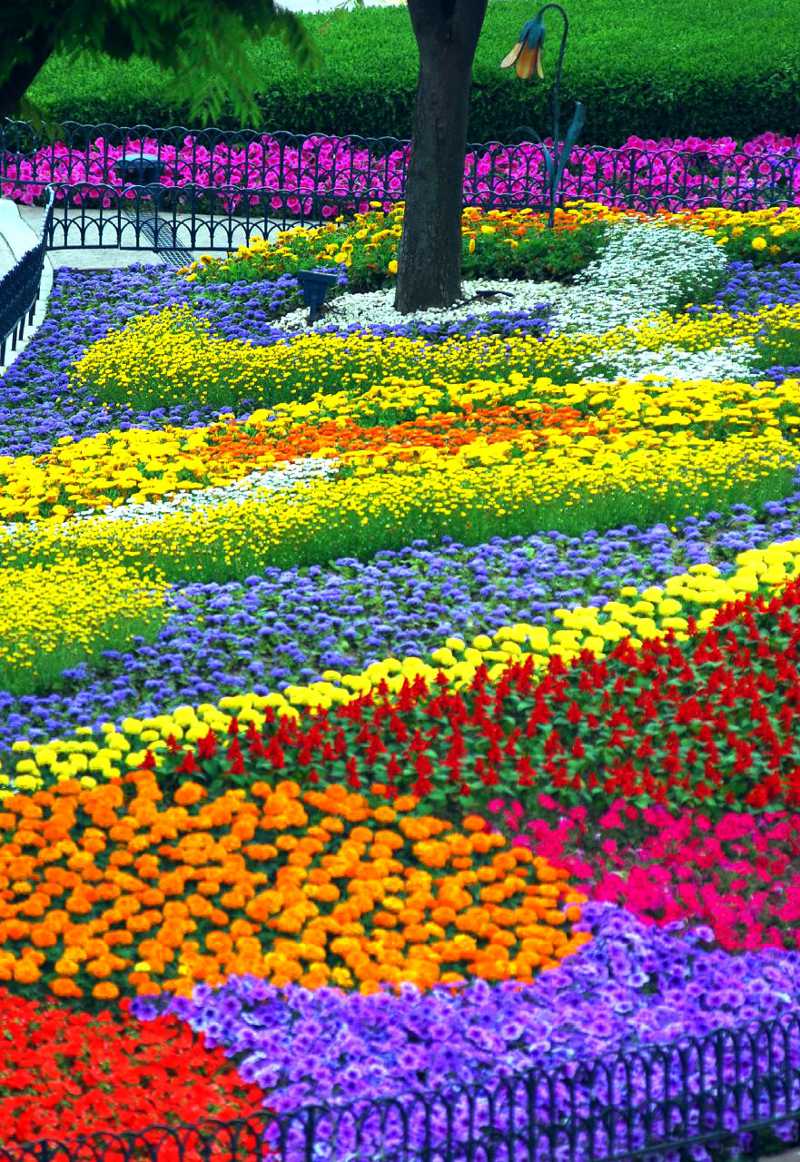FWP:
SETS == A,B; GENERATORS;
PARALLELISM; REPETITION
SOUND EFFECTS: {26,7}
This is one of those verses that looks innocent and simple-- until you start to take it apart and try to put it together again. Then, just to continue the garden metaphor, it becomes a real can of worms.
Let's consider (1a) and (2a) first, since all the commentators agree on them. 'Where we see your footstep, we see flowerbed-flowerbed-paradise', is more or less the structure. This amounts to 'Where we see A, we see B'. This can imply any of the following: (1) A is B; (2) A exists, but B does not; (3) A does not exist, but B does; (4) A and B always exist as a pair; (5) A and B are so much alike that we cannot tell them apart. Let's run the verse through these five logical possibilities:
(1) A is B: The springlike radiance of paradise itself, with all its profusion of flowerbeds and verdure, is (merely?) your footprint. You are probably God, but if not then you are the divinely beautiful and powerful beloved. Your footprint exists, and so does paradise.
(2) A exists, but B does not: There's no such thing as paradise; it too, like this world, is only a shadow of Your presence. When we see your footprint, we (foolishly? or crazily? or mystically?) think that this is the flowerbed-field of paradise. Your footprint exists; paradise does not exist.
(3) A does not exist, but B does: In our longing and desperation for contact, we think we see the beloved's footprint. But this 'footprint' is really nothing but mere flowerbeds, mere paradise. We are tragically deceived. Gardens and paradises can be seen; your footprint cannot.
(4) A and B always exist as a pair: Wherever you set foot, flowerbeds and paradises spring up all around your every footstep. That's why we always see them together.
(5) A and B are so much alike that we cannot tell them apart: Even the smallest trace of you is so adorable that the very sight of your footprint is (or: is like) the sight of paradise. (Your footprint is shaped like an oval but slightly irregular flowerbed, and can perhaps be imagined to be very slightly reddened with rosy henna from your feet.) We have a choice of similes and metaphors here, and lots of ways to read this.
Not content with even this much logical complexity, Ghalib has provided another-- and even more open-ended-- way for us to read the verse. Look at (1b) and (2b). If jahāñ is taken to mean 'world', then the two lines are strictly parallel, and it's very inviting to read them that way too-- in fact, how could we not? Now we have, 'We see the world as your footstep, we see flowerbeds as paradise.' Or, to highlight the logical structure, 'We see A as B; we see C as D'. Now each of these could be run through most (though perhaps not #4) of the five possibilities above, generating many fresh readings.
And then, on this (1b) and (2b) reading, we would still have to answer the question, what is the relationship between the two lines? Do they refer to the same situation? To similar ones? To contrasting ones? Here we would end up with still more wildly ramifying branches on the permutation tree. I'm not sure the exercise of parsing them all out needs to be done, since many of the possibilities would resemble fancier-- since more complex, given the two independently varying lines-- forms of the five possibilities analyzed above. Besides, you get the idea. Imagine Ghalib's pleasure in setting up these little verbal torture-devices-- and imagine his frustration in realizing how many members of his audience either didn't get them, or didn't like them if they did. The commentators, on the whole, seem to continue that attitude.
Because of the conspicuous repetition of the alif -filled ḳhiyābāñ ḳhiyābāñ , the verse also has wonderful sound effects. Since it's such a short meter, fully one-fourth of the whole verse consists only of that hypnotic pair, 'flowerbed-flowerbed'. When we consider that it's an opening-verse, and that the ghazal has the exceptionally long refrain of dekhte haiñ , we can see how brilliantly the amount of rhythm and sheer incantatory repetition have been built into the verse. Compare the use of some of these same sound effects in {283x,5}.
Compare the slightlier crazier perspective of {80,10x}. For a similar doubly meaningful use of jahāñ , see {378x,7}.
Compare Mir's similarly hypnotic use of repetition in M{938,4}. There's also the sense of being overwhelmed by visions of the divine, in M{482,2}. And Mir does his own tricks with jahāñ in M{1882,2}.

Nazm:
That is, every footprint is a flowerbed of paradise. (97)
== Nazm page 97